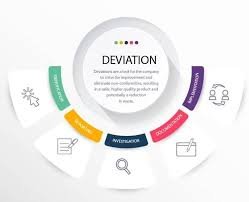Deviation Control in Pharmaceuticals

📌 Deviation Control in Pharmaceuticals
Definition:
Deviation control in pharmaceuticals refers to the systematic process of identifying, documenting, investigating, and resolving any departure from approved processes, procedures, or specifications in a GMP-regulated environment.
🔹 Types of Deviations
-
Planned Deviation
-
Temporary and intentional departure from SOPs or processes.
-
Requires prior approval.
-
Example: Using alternate equipment during maintenance.
-
-
Unplanned Deviation
-
Unintentional and unexpected departure.
-
Reported immediately, followed by investigation and corrective action.
-
Example: Power failure during manufacturing, equipment breakdown.
-
🔹 Deviation Control Process
-
Identification & Reporting
-
Any employee can report a deviation immediately.
-
Use standard deviation reporting forms.
-
-
Documentation
-
Record details such as date, batch number, equipment, material, and description of deviation.
-
-
Investigation
-
Perform root cause analysis (RCA) using tools like Fishbone diagram, 5 Whys, etc.
-
Assess potential product impact.
-
-
Risk Assessment
-
Classify deviations as Minor, Major, or Critical based on severity and product impact.
-
-
Corrective & Preventive Actions (CAPA)
-
Implement corrective action to address immediate issue.
-
Implement preventive measures to avoid recurrence.
-
-
Review & Closure
-
Quality Assurance (QA) ensures completeness of investigation and effectiveness of CAPA.
-
Final approval by QA Head.
-
🔹 Importance of Deviation Control
-
Ensures patient safety and product quality.
-
Maintains regulatory compliance with GMP, FDA, and EMA standards.
-
Supports continuous improvement in pharmaceutical manufacturing.
-
Provides data for trend analysis and preventive actions.
🎓 Discover one of the best Complete Pharmaceutical Quality Assurance Course available —click below to explore the course that’s shaping future in QA Course skills.

